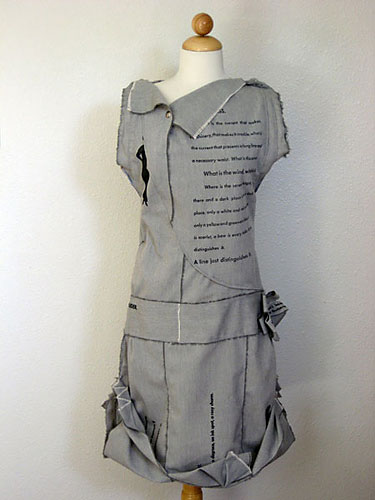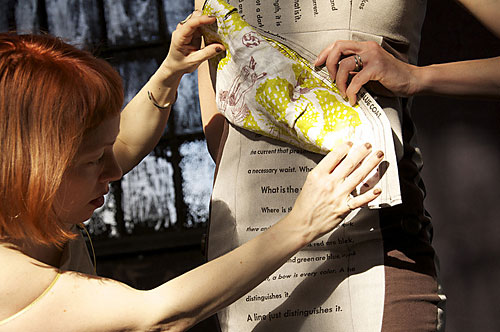|
One of the short texts in Gertrude Stein's masterpiece of modernist verse," Tender Buttons, is called "A Blue Coat."
"A blue coat is guided guided away, guided and guided away, that is the particular color that is used for that length and not any width not even more than a shadow."
Another one is called "The Long Dress." It begins:
"What is the current that makes machinery, that makes it crackle, what is the current that presents a long line and a necessary waist. What is this current."
One wants to ask: "Lizzy, do you understand?" – just as Stein herself used to ask in her detective novel Blood on the Dining Room Floor, addressing the suspect of the famous Fall River murders. I doubt Lizzy Borden could have told us any more about murder than about creation. In order to understand the mysteries of Stein's Tender Buttons one may have to dive in and wrap oneself into the language to find clues. One may have to slip into the text as into a skin or a garment, wear it around for a while – then something might transpire, catch one, even stick and make sense.
This is exactly what artist and poet Katrina Rodabaugh attempted quite literally. She chose 4 pieces from Tender Buttons: "A blue Coat," "The Long dress," "The Handkerchief" and "The Petticoat," and invited women of diverse arts and crafts to create a poetic reflection that would turn Stein's coats, dresses, handkerchiefs and petticoats into touchable, even wearable works of art.
Tender Buttons, from 1914, has often been called Stein's "abstract" or "Cubist" writing, a collection of very short poems that aren't poems at all in the classic, conventional sense. They are strange, lyrical, rhythmical assemblages of words, perhaps best described simply as short texts. The young artist told me she was "moved" by Stein and her overwhelming influence on young writers and artists like herself. What about Stein's writing moved her? The "simplicity of ordinary language," she explained to me, "while the combination of words is so complex and mysterious."
Rodabaugh used to work as a teaching assistant in the Book Art Studio at Mills College while finishing her graduate work in poetry. "I loved working with the letterpress and bookbinding students," she said, "to incorporate images and text into paper and fabric projects. I also loved having access to all that gorgeous letterpress equipment including drawers of wood type, stacks of ornamental borders, and an assortment of movable metal type."
For "The Dresses/ Objects Project" she started out with recycled fabric in a beautiful color I would call "pigeon-on-the-grass-alas-blue-grey". Instead of printing with a letter press on paper, as she had done in the past, she used a letter press directly on the fabric: the four blocks of text alternated with the silhouettes of two women in twenties fashion – the time when Stein's salon famously attracted the Lost Generation. Some of the letters in Rodabaugh's blocks of text were stitched or embroidered with golden threads.
This basic material was provided to a number of designers and artists to be used, at least in part, for their creations. She invited them to use the Roaring Twenties fashion as their take-off and reflect on the intersection of arts and crafts and, of course, gender. Her artistic challenge was nicely set by this limited scheme, and also by the fact that some of the participants had never held a sewing needle in their hands and certainly never thought of making a dress, a coat, a petticoat, or even a handkerchief. Some of her chosen creators for the show were furniture designers, others printmakers, fiber artists, or visual artists, but only a few were dress makers or owned their own fashion design companies.
What resulted was one of the most charming, original, and joyful exhibitions of this past summer – an assemblage of wearable art pieces as eccentric and sometimes riddle-like as Stein's writing. For Stein fashion fans who missed the event, the upcoming "Summer of Stein" that will roll into San Francisco next year, some of the dresses will be on view again, at the San Francisco Center of the Book.
The opening gathered some 30 women participants who modeled the dresses, danced, made music and took photographs – the latter of which filled the walls of the gallery. The exhibition closed with a poetry reading which, of course, was also inspired by the great ancestress of all things avantgarde.
The gallery, Z Space at Theater Artaud in San Francisco, surrounded by industrial buildings, was arranged like a sewing or fashion design workshop. At the head, a table with a sewing machine, where Katrina Rodabaugh was at work during certain gallery hours, entertained by friends, while she was pinning up and finishing one last dress for the exhibition. Around this lively hearth the designer dresses were on display on dress forms, some of them theatrically lit, hanging on the walls or on clothes racks. Every one of them was a piece of art warranting a thorough discovery – like a sculpture or objet d'art. The most baroque creation needed a whole rack for its long, voluminous folds and "mermaid train", linked by a long twisted cord to the front of the long stretch-fabric dress with several bags over the belly: were they bags for fish eggs or for babies? The viewer could take an amused guess about pregnancy as performance: the umbilical cord and trailing placenta were evoked in theatrical, highly colorful fashion by San Francisco artist and costume designer Ambra Sultzbaugh, who happened to be pregnant at the time of her creation.
 |
Katrina Rodabaugh's own finished dress could have been on any runway in Milan or Paris: an elegant cocktail dress with side rosettes, sculpted skirt and snap closures.
Buttons of course were a tender, pervasive theme. Fashion design duo Moriah Carlson and Alice Wu of "Feral Childe," New York, buttoned a ruffled belt to the back of a coat made for San Francisco fog with a prominent collar that unfolds into a hood. Furniture maker Alison Mc Lennan and her partner Rebecca Overacre from Oakland sculpted buttons from wood and defied gender with a tight vest and cravat. This androgynous touch, however, was the exception at the exhibition. There were no male dresses, unless you wanted to look a bit askance at the hugely overlong dress by installation artist and theater prop designer Kehren Barbour that was clearly inspired by Stein's "The Long Dress." A seven foot guy could comfortable have worn this straight, loose flapper dress made of "utilitarian" fabrics (which a male viewer read as "kitchen towels"). Was the dress a très gay invitation to enter Alice B. Toklas's kitchen and add a few hash brownies of "his" own? After all, the divine brownies had been suggested to Alice with malicious humor by a gay friend… But then, Vanessa Filley (of Moira & Obbie in Chicago) presented an even naughtier invitation to the fashion kitchen with her hobble skirt and its sexy little apron…

The complete text of the poem "The Long dress" explains it all:
"What is the current that makes machinery, that makes it crackle, what is the current that presents a long line and a necessary waist. What is this current.
What is the wind, what is it.
What is the serene length, it is there and a dark place is not a dark place, only a white and red are black, only a yellow and green are blue, a pink is scarlet, a bow is every color. A line distinguishes it. A line just distinguishes it."
Read from today's gay perspective it is small wonder that a young generation could get excited by the connotations and allusions in Stein's words.
Next to long dress, a short dress with a transparent front panel, by graphic designer Pilar Nadal from New York, distinguishes itself it as the dream dress for any young would-be writer: hidden in the folds above the seam was a little note book. If only Gertie could have known….
The most romantic dress was a modern play on a wedding dress by artist and crafter Marcie Farwell of San Francisco, who had worked for a wedding designer. Behind a colorful patchwork skirt trailed a train with Stein's text embroidered in golden letters like butterfly or fairy wings. Was it an homage to Gertrude and Alice who had felt wedded to each other in their first year, in 1907, on their honeymoon in Venice?
I do not remember many handkerchiefs in the exhibition, although the Steinese text seemed to speak for many of the garments at Gallery Z:
A Handkerchief
"A winning of all the blessings, a sample not a sample because there is no worry."
Indeed, a bold lack of worry showed in purposefully unfinished seams, winningly haphazard pleats or ruffles, words coyly hidden in the back of a dress or flirtatiously peeking out from under a lapel – samples of perfection in their sewing imperfection.
Every garment was for sale, going from $300 to $750, a steal for this brand-new fashion trend that will predictably grow like a wild-fire. Buyers are welcome to contact the artist at her website www.katrinarodabaugh.com. With such tender buttons to be unbuttoned, I am sure the visitors didn't mind that gender in this room was almost entirely bent and folded toward the feminine…
Also speaking to writerly obsessions was the dress covered with ink stains by local artist Sasha Duerr who works with natural dyes. And although Rodabaugh's blue-grey fabric didn't seem to inspire petticoats, it was obvious that the spirit of Stein's one-line poem had its slanted, pervasive effect on the whole group:
"A Petticoat.
A light white, a disgrace, an ink spot, a rosy charm."
Just think about it, now that Fall fashion is here: could anybody who is everybody resist going dressed in Gertrude Stein?
Photos-Katrina Rodabaugh
(except as otherwise indicated)
|




